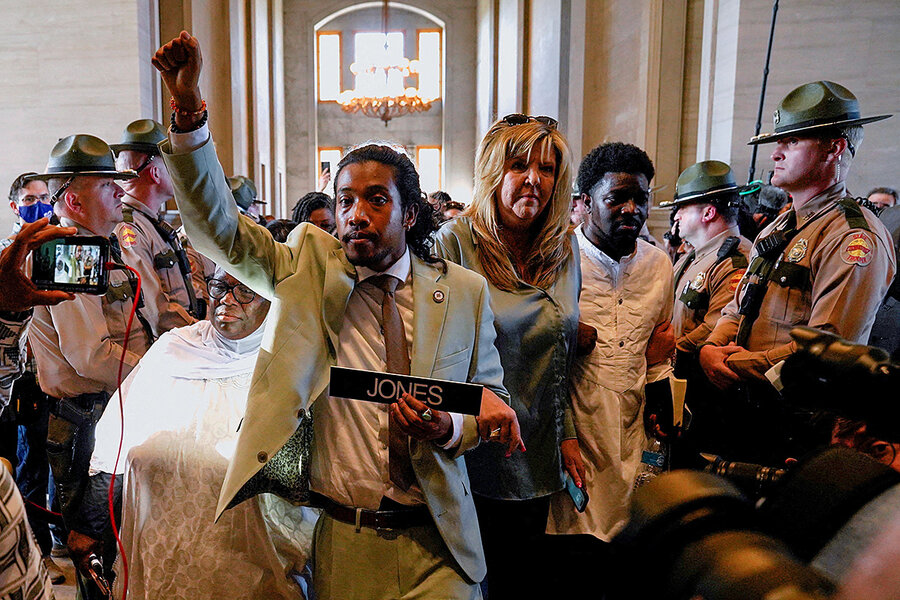Six decades after civil rights, a new era of protest in Nashville
Loading...
| Nashville, Tenn.
In many ways, the scene in Nashville today feels like a 1960s redux: A younger generation seeking racial equity is pushing for change and upsetting the status quo. At the same time, there are notable differences between the two movements, as well as the political and social context that surrounds them.
While ’60s civil rights activists followed a strict set of rules – dress well, don’t laugh, don’t strike back – a number of today’s activists are brash, using a megaphone in the legislative chamber. After being expelled from the state House of Representatives last week for leading a protest there, and then reinstated yesterday on a wave of public outrage, Rep. Justin Jones called for the Republican House speaker to resign.
Why We Wrote This
Protests in Nashville this week echo an earlier era of Black Americans speaking out. What began as a call for action on gun violence has broadened – and drawn national attention.
Compared to the ’60s sit-ins, the policy goals of the Nashville protests aren’t as clearly defined. They began two weeks ago, focused on gun control. Now they’re also about democracy, civil rights, and restoring “power to the people.” Whether the leaders of Tennessee’s new “Good Trouble” caucus can score larger wins remains to be seen.
“We’re here to disrupt in every single way,” says state Sen. Charlane Oliver. “We know what’s at stake here. We have been beating down the door from the outside for years.”
The march started in North Nashville, near the home of Z. Alexander Looby, a Black lawyer and city councilman whose house had been bombed the day before. It began as 1,500 protesters, walking silently. By the time it reached its destination – the city courthouse – there were an estimated 3,000.
April 19, 1960 was a turning point for Nashville’s sit-in movement. Since February, students had been trying to integrate the city’s lunch counters. The bundle of dynamite thrown at Mr. Looby’s home convinced the public that the resistance had become more extreme than the protesters. Meeting the marchers outside the courthouse, Nashville’s mayor relented.
Yesterday, more than six decades later, another crowd marched through Nashville. It started as a small protest on the plaza of city hall. By the time it reached the statehouse, it also had surged to a similar size. This time, the marchers were rowdier. They held protest signs. They chanted “no justice, no peace.”
Why We Wrote This
Protests in Nashville this week echo an earlier era of Black Americans speaking out. What began as a call for action on gun violence has broadened – and drawn national attention.
When they reached the statehouse steps, they too claimed a victory: Justin Jones, one of two state representatives who were expelled last Thursday after leading a disruptive protest in the House chambers, was reinstated to his old seat until a special election. The same is expected for Justin Pearson in Memphis tomorrow.
In many ways, the scene in Nashville today feels like a return to the 1960s: A younger generation is agitating the state’s power structure and seeking what they see as justice. At the same time, the movements differ in style and substance, and social context.
Nashville’s civil rights era activists followed a strict set of rules – dress well, don’t laugh, don’t strike back. Today some are willing to be more brash. After his second swearing in, Representative Jones again grabbed a megaphone and called for the Republican House speaker to resign. In the 1960s, segregation offered clear targets for long-term campaigns. The policy goals of today’s leaders in Nashville are less defined. Their protests began two weeks ago, focused on gun control. But they also speak of democracy, civil rights, and restoring “power to the people.”
The leaders of Tennessee’s “Good Trouble” caucus may both soon be back in office and emboldened. But whether they can turn their trouble – and their new national support – into more policy good remains to be seen.
“We're here to disrupt in every single way,” says state Sen. Charlane Oliver, aligned with Reps. Pearson and Jones. “We know what's at stake here. We have been beating down the door from the outside for years.”
Outrage over gun violence
The first protest began three days after a mass shooting at a private Christian school in the city’s Green Hills neighborhood. Around 1,000 demonstrators filled the statehouse lobby and the chamber galleries. That’s when Messrs. Jones and Pearson approached the speaker’s well with a megaphone, leading chants for gun control.
Session didn’t resume until almost an hour later, after the galleries were cleared.
For the two representatives – especially Mr. Jones – this is the rule, not the exception. Their style of politics welcomes disruption. After the murder of George Floyd in 2020, Mr. Jones led a protest in the plaza outside the statehouse – for 62 days. The year before, he was charged after throwing a cup of tea at the then House speaker.
“All three of us come with this reputation of agitation and disruption, but also results,” says Ms. Oliver, who helped organize the city’s largest Black Lives Matter rally in 2020 and registered 91,000 Black voters in 2018. “They're threatened by that.”
A week after the recent gun-control protest, the Republican supermajority in the House voted to expel Mr. Jones, and by a lesser margin Mr. Pearson. Rep. Gloria Johnson, who had joined their protest, fell one vote shy of joining them.
Even some prominent Tennessee Republicans say the moves went too far.
“It didn’t even remotely rise to the level of expulsion,” says Victor Ashe, former Republican mayor of Knoxville and former aide to U.S. Sen. Howard Baker. “The consequences from a Republican standpoint were disastrous.”
The lawmakers had broken House rules, he says, but no Tennessee lawmaker had ever been expelled for breaching decorum. And expelling two young Black lawmakers while voting to keep the white woman? To many in Nashville and across the country, this was too extreme.
Filling the vacant seats until there’s a special election later fell to the city governments of the lawmakers’ districts. Nashville unanimously reinstated Mr. Jones yesterday. Shelby County is likely to do the same in Memphis tomorrow for Mr. Pearson. After the Nashville vote, thousands began their march toward the statehouse, carrying protest signs, and chanting “No justice, no peace.”
“Happy Easter Monday, because we are resurrecting a movement across the state,” Mr. Jones said at the rally.
The civil rights era model
When this type of movement took place in the 1960s, its defining quality was its discipline.
The students who led Nashville’s sit-ins trained in nonviolence and studied philosophy. Martin Luther King Jr. called it the best-organized effort in the country.
Their mission was simple and morally unimpeachable. Everyone, regardless of their skin color, should be able to get a sandwich in public. Their tactics too were designed to win public support. Protesters wore suits, so that if they were arrested they would look like they were going to church. They were quiet and polite, for even the white employees they challenged were surely also anxious.
And they were centrally organized. That’s why, after their first victory, they quickly moved on to other institutions: department stores, movie theaters, pools.
There are echoes of that civil rights era and its aftermath today.
To his reinstatement, Mr. Jones wore a light, tailored suit – reminiscent of the sit-in protesters’ Sunday best. He raised his fist in the Black Power salute, famously seen in the 1968 Olympics. Mr. Pearson sports an afro and speaks in the cadence of Civil Rights era speeches.
But at times their tactics – at least Mr. Jones’ – feel less policy focused and more provocative.
At a past protest, Mr. Jones shoved a traffic cone through a truck window when he felt the driver insulted him. At another demonstration, during which the city courthouse was partially set on fire, he climbed atop a police car.
“This has been building,” says Ms. Oliver. “The megaphone moment was the crescendo.”
Leaders with a track record
Ms. Oliver and her allies do care about policy, as well as being heard.
Ms. Oliver is a rare freshman senator with a bill that might become law. Her proposal to limit developers from harassing people to sell their homes advanced from committee with bipartisan support.
Back when he was a middle schooler, Mr. Pearson arranged to speak in front of the Shelby County Board of Education in Memphis. He called for the board to buy books the students needed. The board bought them. More than a decade later, he founded a group in Memphis that successfully fought an oil pipeline that would’ve run through poor, Black neighborhoods.
They’ve had clear policy success. But as state Democrats sense a moment to organize Tennessee’s major cities – even compete statewide again – yesterday’s march still doesn’t hint at how to turn activism into law.
Yesterday’s march rose out of opposition, opposition to Republican political overreach, opposition to loosened gun laws that many say have increased gun crime. For the movement to mature, it will need to find out what it’s for.
Their first policy push will likely be gun control, says Shelby County Commissioner Mickell Lowery. But it’s hard to see that passing in the statehouse – or changing the majority in Tennessee.
“It’s an uphill battle,” says Commissioner Lowery. “Obviously, nothing like that comes easy.”
But this movement doesn’t need to be the 1960s, when activism translated so clearly into success. To Ms. Oliver, challenging the state’s way of doing business is success alone.
“When you know that it is your divine calling to be here, to stand up to the forces that don’t want you here, then I’m okay with whatever the consequences are,” she says.
“As long as I’m standing on the right side.”











